- Travel experiences, insights and TIPS for those visiting scenic and lovely Sikkim and crowded Darjeeling.
Introduction and Background
Feeling weary and exhausted, my eyes were beginning to droop, as our plane took off from Bagdogra. When a fellow passenger asked me about my impression of Sikkim, I said “War and Peace” referring to the extensive presence of the Army and the Buddhist Monks visible in every corner of the state. Both coexist to achieve the same objective-peace.
Sikkim shares an extensive border with Tibet. Civilians can reach the Indo China Border at
Nathu La and Zero Point. Nathu La was
the site of the Indo-China conflict in 1967. The 2020 Galwan Valley conflict in
Ladakh makes one realize the need for the overwhelming army presence.
The state lies in the heart of the Himalayas with altitudes varying from 5,600 feet in Gangtok to 28,000 feet in the peaks. The terrain is marked by colossal, gigantic mountains with snow clad peaks, which are both foreboding and scenic. Narrow winding roads snaking through high altitudes are barely broad enough to take one SUV.
Some stretches had old single lane wobbly bridges.
Signboards at both ends indicated (warned is a better word) that only one
vehicle should drive on the bridge at a time. It is an instruction that was
religiously obeyed by all drivers.
Driving in Sikkim is not for the faint hearted or
those accustomed only to city driving. It calls for a very good judgment and discipline.
The remoteness of the state can be gauged from the
fact, that Sikkim got its first airport-Pakyong, as recently as 2018. The
operation of the airport is at the will of the weather gods. The first railway line is under construction. The
terrain is hilly so road and rail connectivity is a challenge though things are
improving.
What was rejuvenating during the long, exhausting drives are the small eating places that dotted most of the drive. Family run – little outlets that served the most incredible momos, maggis and more. Pricing was modest, Rs 50-70 per plate of eight hot steaming vegetarian momos. The best part was that they were served with such warmth that it made us feel welcomed. A spicy sauce was the icing on the cake.
Relishing Momos at close to Zero temperatures
is an experience I will cherish for life.
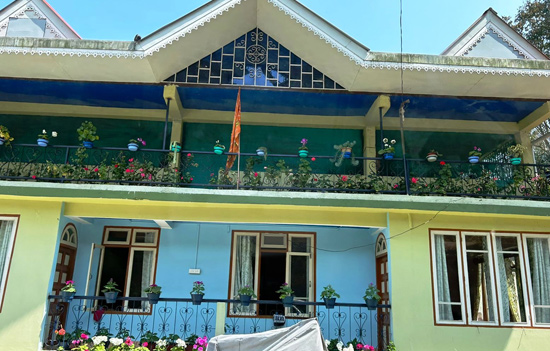 Local home with lots of flowers.
Local home with lots of flowers.
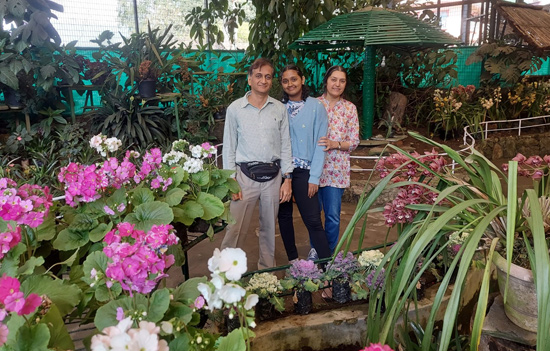 Flower nursery in Gangtok.
Flower nursery in Gangtok.
One of the most captivating sights of the villages and
towns are the cottages of the common people. Most homes have a row of small
colorful pots with beautiful flowers of several hues. A great climate and low
pollution are probably the ingredients.
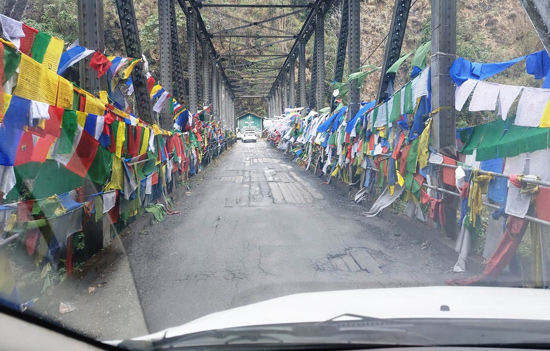 Buddhist flags.
Buddhist flags.
One of the most ubiquitous sights across Sikkim is the
presence of flags of various colors with Buddhist inscriptions written on them.
Typically planted by monks in the most remote of areas, they are considered auspicious.
North Sikkim has two main places for tourists namely Lachen and Lachung. You can do either or both depending on the number of days on hand and what you are looking for. We did Lachung i.e. covered below so here is some information about Lachen. We visited in March 2023.
About Lachen
Lachen is app 105 kms from Gangtok. It takes 4-5
hours. Enroute to Lachen is town of Mangan. Shared vehicles ply from Gangtok to
Mangan. In the hills anything can happen for e.g. accident, landslide so plan
accordingly.
The places to visit are Lachen Monastery,
Shingba Rhododendron Sanctuary, Gurudongmar Lake (17,100 feet), Chopta Valley,
Thangu Valley, Tso Lhamo Lake, Lhonak Valley or Muguthang Valley and Green Lake.
Source
Visit Phensang Monastery, very beautiful, that goes back to 1721.
Chopta Valley is enroute to Gurudongmar Lake. Get acclimatized before you visit the lake and eat before going. Was told the Army does not allow anyone at the lake after about 2 pm so reach early and check Army rules before going. “Located just 10 km from
Gurudongmar Lake, the Tso Lhamo Lake is the highest altitude lake in India and
14th highest in the world, and is also one of the must visit places
to see in Lachen.”
To see
Gurudongmar Lake album
To read a good travelogue on things to do in Lachen, North Sikkim
Here is a day wise program that we did across Sikkim.
Day 1 Drive from Bagdogra Airport
to Gangtok
The drive of approximately 120 kms took 4 hours. The route is scenic and passes through thick
foliage of Sal trees alongside the Teesta River. River Rafting is a popular
activity.
Hacking through the forest, are huge blocks of concrete
and steel for the construction of the first railway line from Sevoke in the
plains to Rangpo (1093 feet) in Sikkim. This railway line will further extend
to Gangtok and ultimately to the border at Nathu La.
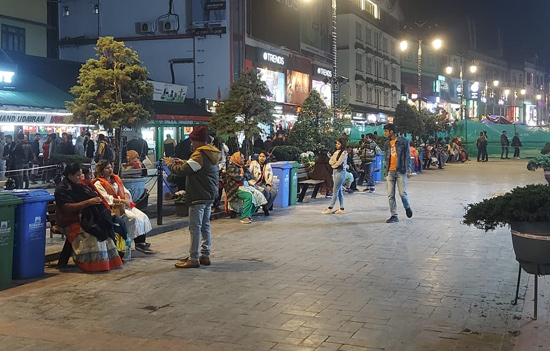 MG road, Gangtok has a festive atmosphere.
MG road, Gangtok has a festive atmosphere.
We spent the evening at MG Road. It has a pedestrian
plaza, outdoor mall and a festive atmosphere. It seemed as if the entire city
had congregated here. The road is full of restaurants, bars and shops selling anything
and everything. Benches in the centre
were occupied by the senior citizens, non-shoppers (mostly married men) or
those wanting to enjoy their ice-creams and coffees. Overall, a very pleasant
experience
Day 2 Baba Harbhajan Mandir/Tsomgo Lake
Drive from Gangtok to Babaji Mandir took about 2.5 to
3 hours.
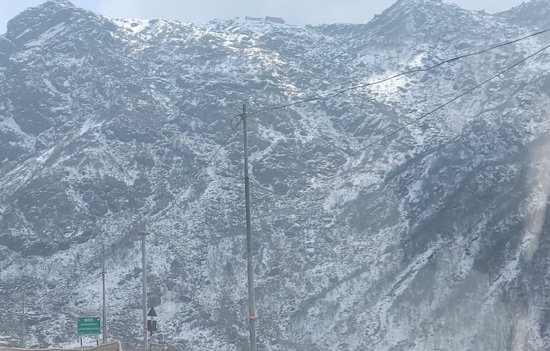 View enroute.
View enroute.
Our first halt was the “Baba Harbhajan Singh Mandir. It is a Samadhi of an Indian soldier who went missing in the mountains four decades ago. Legend has it that he appeared in the dreams of soldiers who eventually found his body after three days.
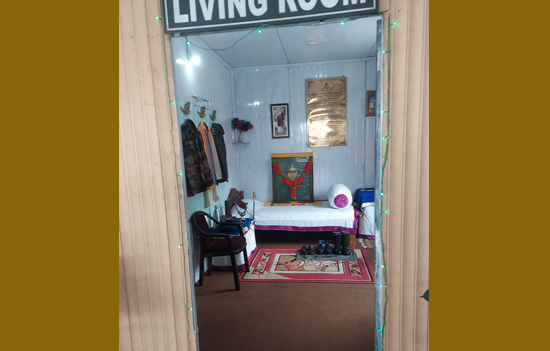 Living room of Baba Harbhajanji.
Living room of Baba Harbhajanji.
The entire region was snowbound and the atmosphere festive. Indian soldiers serve prasad and patriotic songs were played in the background. At that moment we felt “proud to be Indian”. There were strict instructions not to photograph the soldiers.
Nathu La is close to Babaji Mandir. Nathu la is closed on Mondays so had to skip.
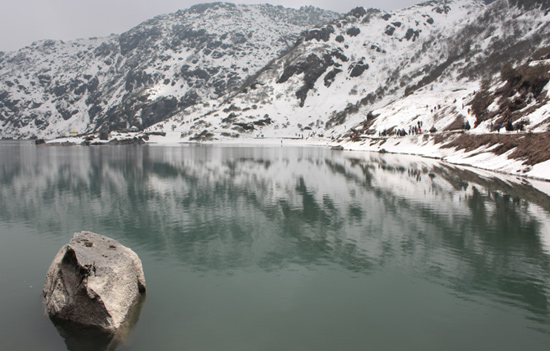 Tsomgo Lake. Pic Pashminu Mansukhani.
Tsomgo Lake. Pic Pashminu Mansukhani.
On our return we stopped by the Tsomgo Lake (also
called Changu Lake). At an altitude of 12400 ft, the lake is surrounded by
beautiful Alpine forests. An incredible sight-shimmering cold, crystal, clear
waters with change colors. Buddhist monks analyse the colors of the lake to
forecast the future. Yaks were outside
the lake for those wished to take a ride. Many posed with the Yaks.
Day 3 Drive to Lachung/Lachung Monastery
The drive from Gangtok to Lachung is a fascinating one
as we go from an elevation of 5,500 ft to 9,600 ft. Long stretches are marked
by small hamlets, villages and towns, with clean roads, neat well-painted
houses are indicative of a high income. Several cars were visible in these
remote thinly populated villages.
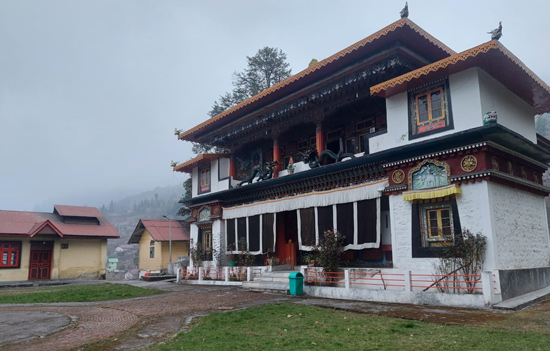 Lachung monastery.
Lachung monastery.
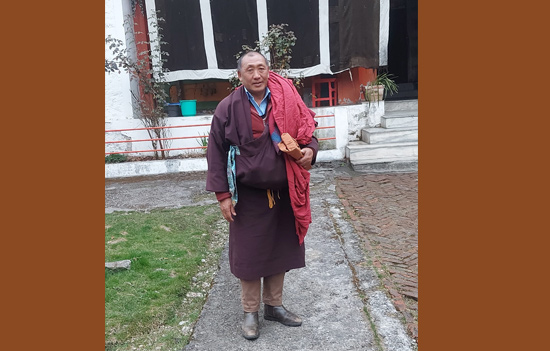 Monk at monastery.
Monk at monastery.
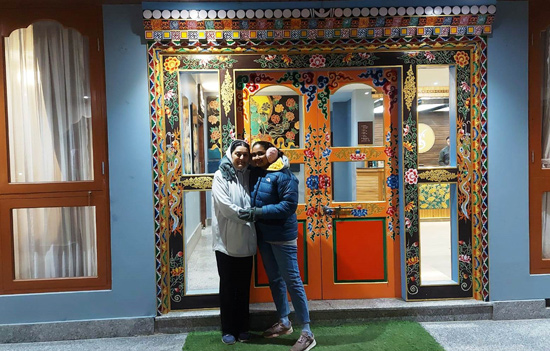 Inside hotel at Lachung.
Inside hotel at Lachung.
The air was biting cold when we reached the top. After checking in, we went to visit the 200 year old Lachung Monastery. Fortunately, we entered when the Monks were performing the evening prayers. We sat in blissful silence. They gave us biscuit packets as “Prasad”.
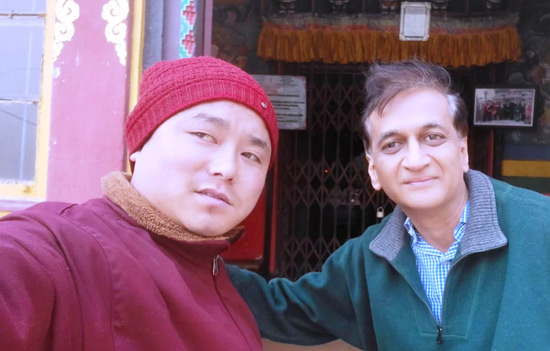 Author with monk.
Author with monk.
The monks were friendly and welcoming. When we
mentioned, we were from Mumbai, their first reaction was Bambai se aaya mera dost.
Day 4 Zero Point/Yumthang- The Valley of Flowers
Early morning, inspite of room heaters, we were shivering so we skipped the
shower. It needs a mind and body of steel to bathe at close to zero degrees.
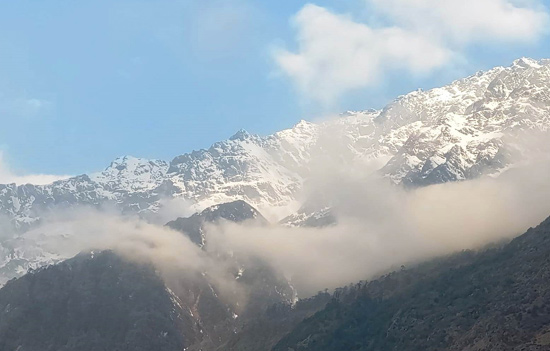 Drive from Lachung to Zero Point.
Drive from Lachung to Zero Point.
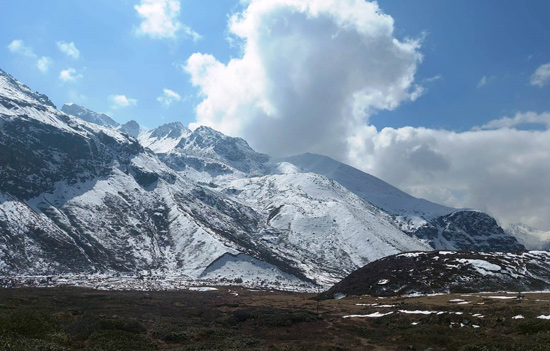
From Lachung we headed to Zero Point (local name Yume Samdong) which is
at a height of 15,000 feet. It is so called Zero Point because it at the end of
a motorable road meant for civilians.
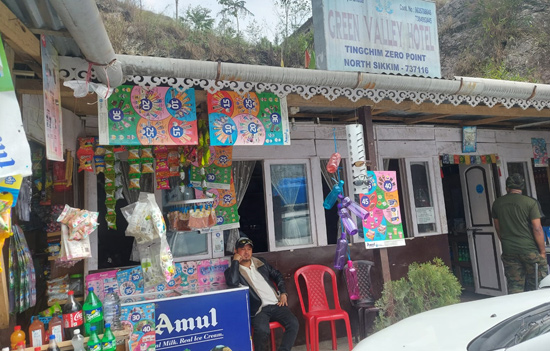 Restaurant close to Zero Point.
Restaurant close to Zero Point.
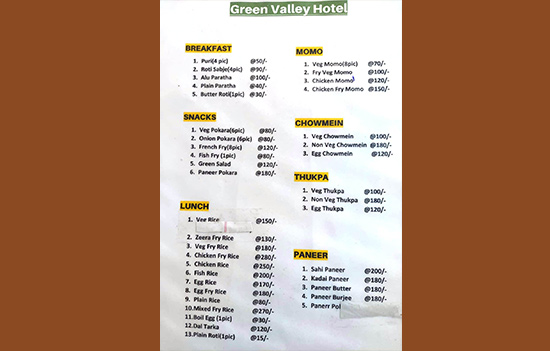 Enough options for vegetarians.
Enough options for vegetarians.
It takes app 2 to 2.5 hours from Lachung. The drive offers magnificent
views of Himalyan peaks. Photography of army camps was strictly forbidden.
Three Cheers to the Indian Army. Weather is harsh and biting cold. They undergo these hardships and risk their lives to protect the nation’s borders.
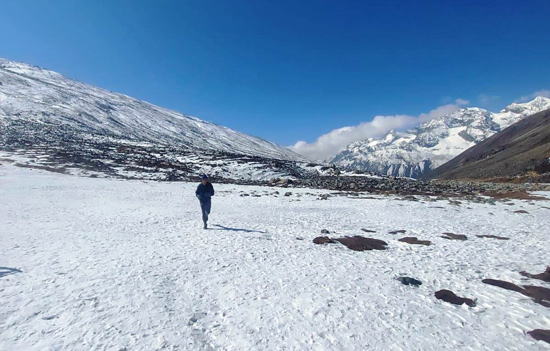
Zero Point is an open stretch covered in snow. There was ample car parking and the road lined with stalls selling snacks. Hot Maggis were very popular. At Rs 70 per plate, no one complained. For some–beer and scotch was also available.
On the return, sadly “Yumthang – the Valley of flowers” (11,800 feet) did not sport a single flower. The
Valley is carpeted with flowers only at the end of winter and after the first
rains. We consoled ourselves by gazing at colorful flowers in private
houses and balconies.
The drive from Lachung to Gangtok took app 5-6 hours.
Day 5 Rumtek Monastery and Drive to
Darjeeling
We headed to the Rumtek Monastery that is an hour’s drive from state capital Gangtok. It is Sikkim’s largest monastery.
Spread over a huge expanse of beautifully landscaped
area, the monastery is of the Karmapa lineage and an exact replica of the
Tibetan Monastery. Built by the 16th Karmapa who fled Tibet in the 1960’s, it boasts of a huge golden Stupa, magnificent statue of Lord Buddha and scriptures from the 16th Century. We were fortunate to meet guide Monay Rai (Tel: +91 85970 89608) who enthralled us with his insightful knowledge of Buddhism. He spoke a few sentences in Marathi to keep us entertained… (obviously we were not the first Mumbaikars to go there.)
 Inside Rumtek Monastery. Pranams.
Inside Rumtek Monastery. Pranams.
From Rumtek starts the Goecha-la Trek. To see album
For
a good travelogue on Lachung
To see
album Monasteries of Sikkim
To see album on Sikkim
including flowers and waterfalls
We skipped going to Siddheshwar Dham
i.e. 5 kms from Namchi in West Sikkim. Namchi is app 3 hours drive from
Gangtok. Here you see a replica of all the 12 Jyotirlingas and
four Dhams and 108 feet high statue of Lord Shiva. If you are not going to Darjeeling consider driving from Pelling to Bagdogra airport/railway station.
For us, the drive from Rumtek to Darjeeling was about 3
hours.
Day 6 Darjeeling
Our hotel was located at Ghoom i.e. 8 kms away from
Darjeeling. Fortunately, close to us was the Ghoom Monastery. I did get a peep
in.
The day was spent at the local touristy sites such as
the Mountaineering Institute, Zoo and a Tea Estate. The city is extremely congested, with
extensive traffic jams even though it was not peak season.
We saw the famed Darjeeling Toy Train. Ticket prices were Rs 1000 per person for a Diesel engine train and Rs 1500/ for the Steam engine. It was over-priced and over-rated in my opinion, since it offered virtually no views. On one side, were the walls of mountains, and on the other – an extended traffic jam. Our driver joked that the only purpose of a seat in the train was that it will enable the traveler to count the number of cars caught in a traffic jam.
To see
album on Darjeeling
The drive from Darjeeling to Bagdogra Airport took app
2.5 hours. If you go via Rohini you see tea estates, old style cottages. Some
have hotels. Lovely drive.
Tips for Tourists
1. Please keep suitable medication incase you are suffering from Motion sickness.
2. High Altitudes may not be everyone’s cup of tea. It could be rather daunting for those of advanced age.
3. Please use the Toilets at the Hotels before a Drive. Public Toilets are terrible.
4. If visiting in winter, warm clothing is absolutely essential. Warm coats, gloves are available at reasonable prices at the MG Road Market in Gangtok.
5. Go off the beaten track and opt to stay at family run B&B’s for a more insightful experience.
6. Visit the Rumtek Monastery and or other monasteries. It is worth it.
7. Enjoy the silence and solitude–it is not meant for the raucous, noisy travelers.
8. Nathu La is closed on Monday so plan accordingly.
9. Tourist season in Sikkim is April to June. For lower rates go in off season. It usually snows at altitudes of higher than 8,000 feet says a local guide.
10. JIO works well in Sikkim so our daughter's phone came in handy.
What we liked about Sikkim was the extraordinary road discipline,
houses with flowers and the general level of cleanliness. However, toilets were
lacking.
We (Miloni Tours and Travels) plan to organize
specialized Tours with a focus on Monastery Visits and living with locals. If this is of interest call me Nayan Marphatia at +91 98203
16986 or mail Nayan.Marphatia@gmail.com Unless stated all pictures by author.
Sikkim is a must visit for it is scenic and has lovely
people.
Also read Haromonious Himalayan Highland